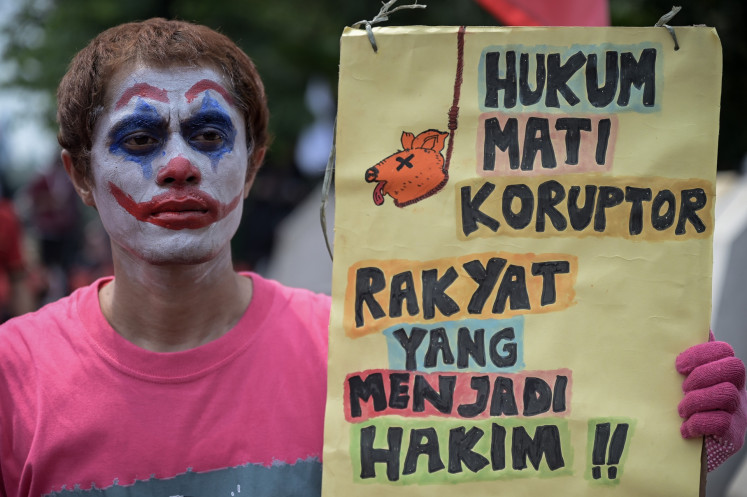Popular Reads
Top Results
Can't find what you're looking for?
View all search resultsPopular Reads
Top Results
Can't find what you're looking for?
View all search resultsGovt told to define coverage details, premium amounts
As part of the implementation of a new health insurance plan in 2014, the government should set insurance premiums and provide details on the facilities and benefits the public can expect
Change text size
Gift Premium Articles
to Anyone
A
s part of the implementation of a new health insurance plan in 2014, the government should set insurance premiums and provide details on the facilities and benefits the public can expect.
Hasbullah Thabrani, a public health expert from University of Indonesia (UI), said a clear explanation of the new health insurance plan would help the public understand their rights.
“It’s important to make sure poor people understand that they will get healthcare coverage when they are sick. At the same time, the wealthy people should be informed of the amount of money they should pay to get their expected healthcare coverage,” he told The Jakarta Post on Sunday.
Healthcare providers – both state and private-run – will also need additional details in order to provide accurate budget allocations for the new insurance plan.
Under this new healthcare plan (known as universal coverage), wealthy people will pay a certain portion of the insurance premiums, while the poor people will get medical treatment for free.
Usman Sumantri, head of community healthcare financing at the Health Ministry, recently said the government was still deliberating regulations on the benefits and additional details of this new plan.
“The kinds of health problems that will be covered and the amount of premium will be explained in a Perpres [Presidential Regulation],” he said, adding that a Government Regulation (PP) will be issued to define which groups in society entitled to free coverage.
According to the Central Statistics Agency (BPS), the number of poor people in Indonesia as of September 2011 reached 29.89 million (or 12.36 percent of total population).
Hasbullah suggested the government should consider the cost of living in the regions before setting the insurance premiums.
The Health Ministry made preparations for the implementation of universal coverage a priority in its health agenda this year, as Law No. 24/2011 on Social Security Providers (BPJS), which will handle a universal health insurance system, is expected to come into force on Jan. 1, 2014.
In anticipation of the implementation of universal health coverage in 2014, Health Minister Endang Rahayu Sedyaningsih said the government would not only require hospitals, especially private providers, to provide more basic rooms, but also to develop more community health centers (Puskesmas) equipped with in-patient healthcare facilities.
“People tend to seek medical care in hospitals, including centers with sophisticated medical technology, whereas community health centers or hospitals with basic facilities actually have adequate capacity to deliver the treatments they need,” she said.
In 2011, the number of community health centers reached 9,133, comprised of 2,957 community health centers with in-patient facilities and 6,176 centers with only out-patient facilities. The “Jampersal” childbirth insurance system is the only program that already provides universal coverage as it provides full coverage to people seeking medical help with childbirth in community health centers.
The Health Ministry is also piloting full coverage for Jamkesmas community health coverage card holders in West Java.
Without adequate facilities, however, implementation of full coverage is unlikely, including for people with Jampersal and Jamkesmas cards.
Citing as an example, Endang said as of 2011, about 63 percent of Indonesian people were covered by health insurance programs, including Jamkesmas, Jamkesda, and Jampersal.
“We have about 2,000 hospitals both public and private, but only one-third of private hospitals agree to deliver services to Jamkesmas card holders,” she said.
In 2011, there were 1,078 health facilities, both public and private, that deliver services to Jamkesmas patients, up from 1,020 in 2010.










